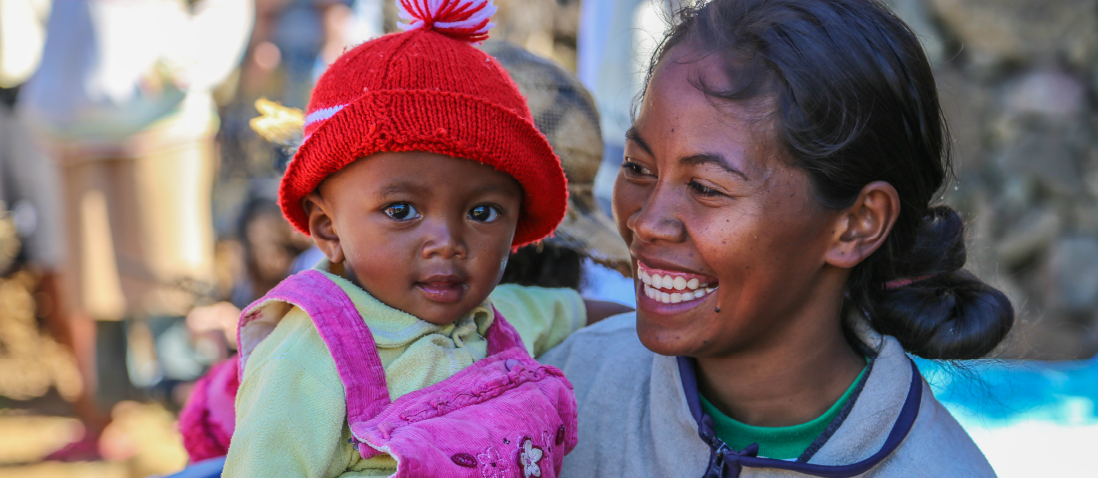 A young mother and her baby in rural Madagascar. Photo: Mohamad Al-Arief/ World Bank
A young mother and her baby in rural Madagascar. Photo: Mohamad Al-Arief/ World Bank
Even before the pandemic, we were already a long way from closing gender gaps in unpaid care work: globally, women did nearly three times as much unpaid care and domestic work as men. After COVID-19, the total amount of unpaid care work only increased in households.
Women and girls take on the bulk of unpaid care work in families and communities when formal services and systems for care, education and health are unable to keep up, or are absent. Men also help out, but the data suggests that women bear the brunt and are unevenly affected. Women who are worse off include informal sector workers with no paid leave, social protection, or ability to work remotely; women living in poverty; single mothers; essential workers; and adolescent girls and women belonging to minority racial and ethnic groups.
COVID or not, the provision of affordable care services and policies have positive effects on women’s economic inclusion: their ability to join the labor force, to earn more or gain more profit, to realize their potential and to get some peace of mind. The recent care crisis only highlighted the severity of the impact, as women left work, closed businesses and girls quit school to take on increasing care loads.
For over a decade, Women, Business and the Law has been examining laws affecting women's participation in the economy. The 2022 edition of the report contributes new pilot data on laws for childcare provision in 95 economies. These first-time measures provide insights into legal frameworks governing the availability, affordability, and quality of childcare services for children below the preprimary school starting age—typically below 3 years—at a global scale.
The availability and regulation of childcare services vary widely across regions. Of the 95 economies examined, 55 regulate provision of childcare services by the public sector . In OECD high-income countries and Europe and Central Asia—the two regions where the state plays a critical role in delivering essential social services—provision of public childcare is nearly universally regulated (Figure 1, panel a). Conversely, the Middle East and North Africa and South Asia have the highest share of economies regulating provision of services by the private sector or employers. (Figure 1, panel b).
Figure 1. Laws regulating public, private, and employer-provided childcare services, by region
The data showcase that close to 80 percent of the economies with existing public childcare frameworks do not mandate its free provision. Cost barriers can hinder the uptake of childcare services, pushing mainly mothers into staying home or adopting other informal arrangements. Also, high operational costs and tight margins can make service providers financially vulnerable, typically translating into higher costs for consumers or limited childcare options available on the market.
Close to 45 percent of the economies examined provide some form of financial support to parents or childcare services providers (private centers or employers). This is the case in the OECD high-income and more than half of the economies in East Asia and Pacific and Europe and Central Asia (Figure 2). The economy-specific context matters, as in more than 85 percent of cases these support measures have conditions—at least with regard to parents. For example, in South Asia, where there is minimal state involvement in childcare provision, the burden of financing childcare falls primarily on households.
The data also examine the availability of preferential tax policies for consumers and childcare service providers, and support of any form specifically targeting the poor. The latter is essential to ease the burden of care for the most economically vulnerable families and to contribute to poverty eradication overall. Only one-third of covered economies provide options targeting low-income families. These options can include, but are not limited to, fee reductions (or exemptions) in Hong Kong SAR, China and Croatia, grants and subsidies in Singapore and Mauritius, and state guarantee of access and priority enrollment in Brazil, Philippines, and Chile.
Figure 2. Financial support for consumers or providers of childcare services, by region
Finally, the quality of childcare service also matters as it impacts the safety and development of children and may affect parental decision to enroll children in outside facilities. The pilot data investigated a set of structural, process, and system quality aspects for both public and private childcare centers. Overall, the data around different quality aspects do not clearly show discernable patterns among regions, and requirements are not always equal for public and private providers. For example, the teacher-to-child ratio or maximum group size are more regulated for private providers in the OECD high-income region, Sub-Saharan Africa, and East Asia and Pacific (figure 3).
Figure 3. Regulation of structural quality for public and private providers of childcare, by region

This new data are a unique tool that can be used by policymakers to identify regulatory childcare gaps and design a range of solutions to tackle the care crisis . First and foremost, it is essential that public financing for childcare is prioritized. Second, the law should also mandate public provision of childcare services, focused on low-income families. Requiring employers to provide childcare services could create the right workplace arrangements to help retain women in the workforce. Where possible, the government should consider financial incentives for employers, parents and the private sector.
Improving the enabling environment for the provision of childcare can be an important source of new jobs. A targeted policy response to address laws and regulations related to availability, affordability, and quality of childcare, in addition to increased financing, can help to take advantage of the current opportunity to facilitate post-pandemic recovery efforts and build stronger economies. The reorganization of childcare in light of the COVID-19 pandemic provides an opportunity to influence gender norms and roles around childcare.
The Women, Business and the Law childcare data can be used by development practitioners when designing operational projects and informing childcare policy dialogue around the world. As we prepare to scale up this line of work, we look forward to future engagements with experts in the field. Future development will be funded through the new World Bank Group Childcare Incentive Fund, launched in April 2022, which is an ambitious cross-sectoral work program to address the childcare challenge in low and middle income countries. Through research, data, policy and operational approaches, this fund aims to drive quality investments in childcare to improve outcomes for women, children, families, businesses, and economies.







Join the Conversation